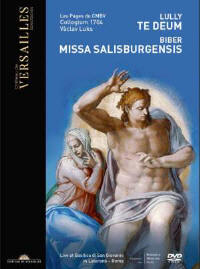Texte paru dans: / Appeared in:
Château de Versaille Spectacles |
|
|
Outil de traduction (Très approximatif) |
|
|
Reviewer:
J. F. Weber This concert, caught live on October 28, 2018 (two weeks before the centennial of Armistice Day), sponsored by France and the Czech Republic, marked for one the end of the war, for the other the foundation of Czechoslovakia, the forerunner of the present state. Lully’s Te Deum clearly served to put France on the program, but the Czech Republic was served equally well by the composer of the Salzburg Mass in 53 parts, for he was born in Wartenberg (then in Bohemia) in 1644. The concert took place at the basilica of St. John Lateran, the cathedral of Rome, a structure that for the most part dates back to the time of Constantine (the apse is a modern extension on the rear). Since Collegium 1704 is a Czech early music chorus and orchestra founded by Luks in 1991 and all the soloists are Czech, the only French component of the performing forces is the children’s choir (boys and girls), Les Pages from the Versailles Center of Baroque Music. They are prominent in the Te Deum, but they are unseen in the Biber until they suddenly appear as the Agnus Dei begins. They stand in the middle rear, singing heartily but not easily identified with one or the other chorus. A performance of the Biber Mass under Luks in the Salzburg cathedral, this time coupled with Monteverdi and certainly dispensing with the children, has already appeared on DVD (Fanfare 41:5). For me, these two works go back to their first recordings (both mono). Both works are set for double choir, the Biber for eight voices in each, so mono sound didn’t begin to do them justice. I acquired Pierre Capdevielle’s recording of the Te Deum on Ducretet-Thomson and later was given the Westminster pressing as well. I eventually acquired stereo recordings under J.-F. Paillard, Jean-Claude Malgoire, and Hervé Niquet. As for the Salzburg Mass, I bought the Joseph Messner recording on Epic (originally made by Philips) when it was attributed to Benevoli for the consecration of the cathedral in 1628. When a second recording was made in stereo under Ireneu Segarra, authorship was up in the air and the composer was listed as anonymous. The third recording under Paul McCreesh had Biber’s name on it in connection with the 1,100th anniversary of the foundation of the city, and the work’s transmission history is amply told in the review (23:4). Ton Koopman’s version was reviewed in the next issue (23:5). Some have been misled by the English translation of the notes here, which refer to “the one thousand and one year anniversary”; the French and German correctly say “les mille-cent ans” (the 1,100 years) and “das 1100. Jubiläum” of the founding of the archdiocese (not of the cathedral). It was not “the millennial celebrations of the church.” Lully’s Te Deum is awash in good stories. It was first performed at the baptism of the composer’s eldest son with Louis XIV as godfather. Since the boy was 13 years old, one must wonder at the unusual postponement of a rite that invariably took place as soon as possible after birth. It was performed again at the marriage of Marie-Louise d’Orléans to the feeble king of Spain at Versailles in 1679; one of the teenagers died a decade later and the other’s death in 1700 brought on the War of the Spanish Succession. At a third performance to celebrate the recovery of Louis XIV, the composer, beating time with a cane, stomped on his foot; the injury resulted in gangrene and death. Both works benefit from the visual offering, lacking only the more elaborate spatial effect of performing the Mass in the four corners of the crossing in the cathedral (the space where the nave, the sanctuary, and the two transepts intersect). For that I must see the earlier DVD. Even so, groups of trumpets and drums are placed on both sides of the basilica for effect. A Blu-ray player and a hi-def 4K television bring out everything the DVD has to offer. The two works are not so far apart as some might think. Their composers were contemporaries, they served two masters of similar taste, and the works were composed less than a decade apart by composers in their early 40s. Two magnificent works of Baroque music are handsomely rendered. Recommended without reserve. |
|




